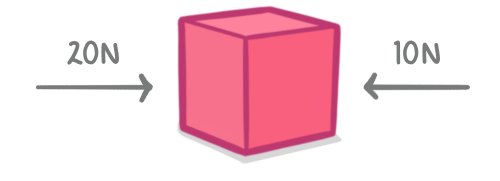Welcome to the Quiz!
This quiz contains 10 questions from a mix of 1 subtopics.

forces / direction / magnitude / type
Free body diagrams use arrows to show all of the acting on an object.
The length of each arrow indicates the of that force.
The direction of each arrow indicates the of the force.
|
The force is the overall force acting on an object, taking into account all the different forces acting on it.
|
Forces acting in opposite directions on the same object can 'cancel out'.
During take-off, a plane has a lift force (upwards force) of 690,000 N and a weight (downwards force) of 600,000 N.
What is the resultant force acting on the plane?
90,000 N downwards
1.15 N downwards
1.15 N upwards
90,000 N upwards
|
A resultant force acts upon an object.
Which two properties might be affected by that resultant force?
Direction and temperature
Density and speed
Direction and mass
Speed and direction
|

What will be the resultant force acting upon this object?
(force arrows are not drawn to scale)
10 N to the left
10 N to the right
10 N to the left
20 N to the right
0 N - no resultant force
|

What will be the resultant force acting upon this object?
(force arrows are not drawn to scale)
0 N - no resultant force
2 N to the right
25 N to the left
30 N to the left
25 N to the right
|

What will be the resultant force acting upon this object?
(force arrows are not drawn to scale)
60 N to the left
60 N to the right
0 N - no resultant force
15 N to the left
45 N to the left
|
If all the forces acting on an object balance out, then we say that the object is in:
Motion
Freefall
Equilibrium
|

The train above is travelling at a constant velocity because the forces acting on it are in equilibrium.
Therefore, the missing force must have a magnitude of newtons to the .
|
A train is travelling at a constant velocity along a flat railway. Three horizontal forces act on the train, two of which are shown on the diagram above.
(force arrows are not drawn to scale)
The size of the third force is N, and the direction of the third force is to the .
|